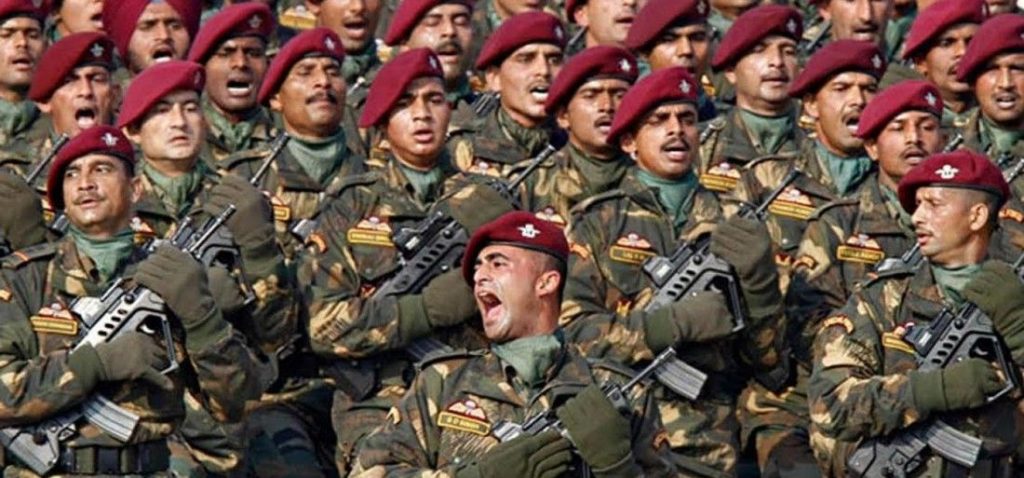We often perceive the Indian Armed Forces as shining examples of equal opportunity and unity.
The Indian army provides employment to more than 1.3 million people and it puzzles us to think of it as an organisation with soldiers from many aspects of diversity. Although bravery has no religion, caste or language and in spite of being projected as the most nationalist and united organisation in the country, the Indian army comprises of regiments that had been constituted on the basis of caste, religion, region and language.
These regiments include; Jammu & Kashmir Light Infantry; Jammu & Kashmir Rifles; Ladakh Scouts; Punjab and Sikh Regiment and Sikh Light Infantry; Dogra and Kumaon Regiments; Garhwal Rifles; Assam, Bihar and Naga Regiment; Arunachal Scouts; Rajput and Jat Regiment; Rajputana Rifles; Maratha Light Infantry; Madras Regiment; Mahar and Gurkha Regiments.
The regiments of Arunachal Pradesh, Assam, Bihar, Jammu and Kashmir, Ladakh, Madras, and Punjab denote the regions that have been used for nomenclature in the regiments in the army. The Sikh regiment has a strong nationalist public perception and derives their identity from a specific religion in an institution like army that has remained secular. The Kumaon, Garhwal and Rajputana regiments reveal the linguistic and ethnic identities that is reflected in the army’s recruitment policy. The Maratha, Mahar, Rajput and Jat regiments on the other hand clearly reveal the embedded casteism in India, while the Gurkha regiment reminds us of the unique British practice of recruiting hill folks, despite their ‘Nepali’ origins.
The Article 14 of the Indian Constitution states that there will not be any discrimination on the basis of religion and province, but the Indian army has, apparently, defended the names of regiments based on caste, religion, region and language and contended that “Certain regiments of the Army are organised on the lines of classification because social, cultural and linguistic homogeneity has been observed to be a force multiplier as a battle winning factor”. Apart from soldiers, the post of President’s Bodyguard is also reserved only for Rajputs, Jats and Sikhs. In 2013, the Indian Army admitted in the Supreme Court that recruitment to President’s Bodyguard (PBG) is open only to
Hindu Rajputs, Hindu Jats and Jat Sikhs, saying it is done purely on “functional requirement” and there is no caste and religion bias in it.
Given the vast landmass India is, it features communities that are diverse in terms of history, culture, and geographical location but an institution like the army is expected to be in operation on uniform, and not diverse lines. The Indian Armed Forces’, as composed today, do not mirror the social diversity of the Indian population. Furthermore, the prevalent Islamophobia is adding to the discrimination on religious lines in the army. There is no data to provide the representation of Muslims in armed forces. The Muslims are heavily under-representation and still they don’t have a regiment of their own like the Sikhs do. The Muslims in Indian Air Force are also prohibited from keeping a beard for ‘sanctity of ensuring discipline’ while the Sikhs are allowed to keep an unshorn beard. These practices are a gross violation of the Constitutional rights of all eligible citizens of India who are legally entitled to equality.
Regardless of army’s explanation, one would like to argue that this is perhaps the right time to have a pragmatic approach in the recruitment process in the Indian army. The seeds for caste-based regiments were sown by the British and we have had a Brahman, Chamar, and Lingayat regiments but they were dissolved before independence. If we can propose to change the names of various historical places, roads, monuments, cities, railway stations, and airports, then there is no reason for not trying to ensure a sense of uniformity in the nomenclature of the regiments in the army.. The names of regiments on the basis of region, caste, language, and religion should be dropped. Former Defence Minister George Fernandes had also turned down the request of the then Deputy PM L K Advani and state chief minister Narendra Modi for demanding a Gujarat regiment.
The war cry slogans of almost all the regiments are dedicated to Hindu gods. The war cries of Gurkha Rifles, Bihar regiment, and Rajput regiment are “Jai Maa Kaali, Ayo Gorkhali”, “Jai Bajrangbali”, and “Bol Bajrangbali Ki Jai” respectively. The Mahar regiment, comprised of Dalits, is the only regiment to have a secular war cry of “Bolo Hindustan Ki Jai”. These instances indeed put forward a challenge to our basic understanding of “We, the People”. We must be bound to each other and must stand up for each other irrespective of our castes and ethnicity.
Army chief General Bipin Rawat had said that people should not get stuck in “microscopic identities” but rise together as one, to join the army to feel the idea of India’s unity. However, the existence of regiments built upon identities contradicts the unity and Constitution’s conception of India. The creation of Special Forces or the Brigade of Guards units in the Army by Field Marshall Cariappa soon after independence were are not based on caste or ethnicity. The Grenadiers, Parachute Infantry units, and Mechanised Battalions of the Army also do not subscribe to religious, linguistic and regional identities in their regimental training centres and are all “mixed” formations. Most importantly, there isn’t any evidence about their not being efficient or courageous enough in the line of Hindu Rajputs, Hindu Jats and Jat Sikhs, saying it is done purely on “functional requirement” and there is no caste and religion bias in it.duty. If anything, they all display extraordinary adherence to military discipline and a dedication to their country.
Disclaimer: The opinions expressed in this article are the personal opinions of the author. The facts and opinions appearing in the article do not reflect the views of NEWSD and NEWSD does not assume any responsibility or liability for the same.


















